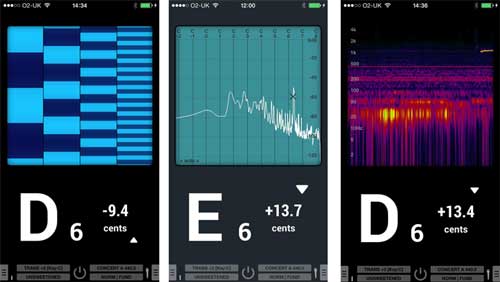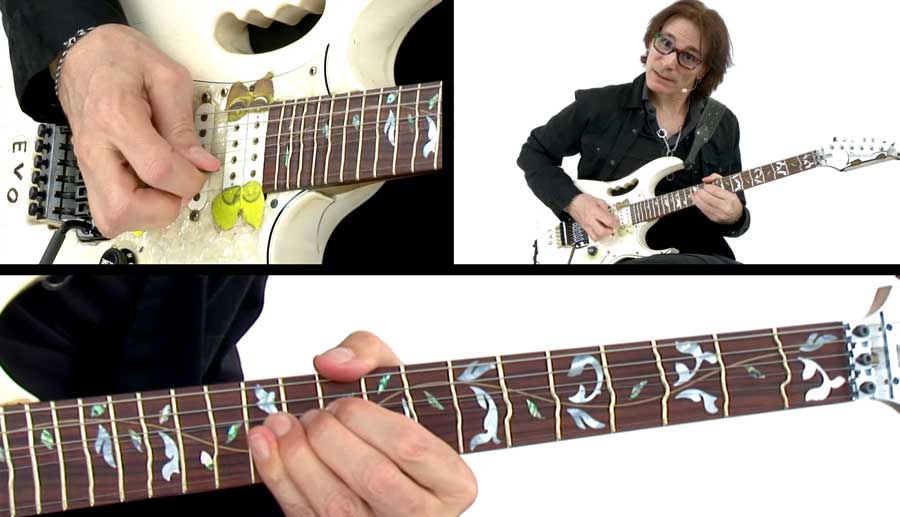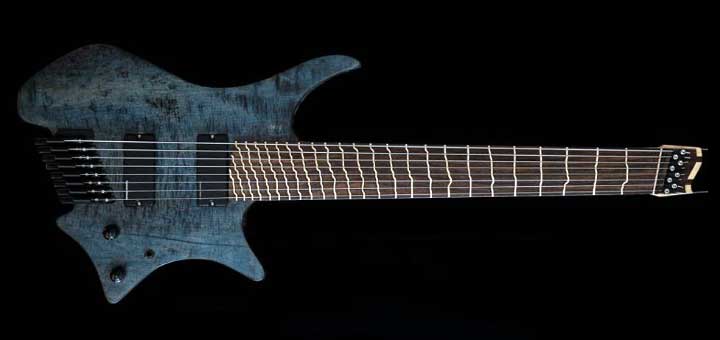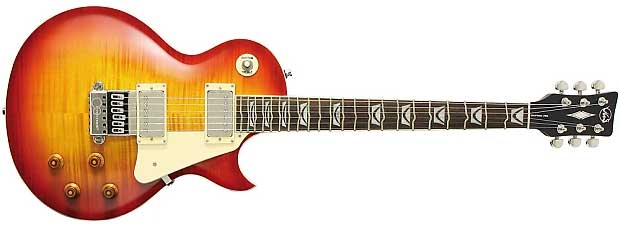Everyone has the same reaction the first time they see a guitar with squiggly frets: what is wrong with that guitar?
True Temperament guitars with their squiggly frets may look weird but have some surprising benefits that overcome a problem you may or may not realize normal straight-fret guitars experience.
In this guide, I will explain True Temperament and why these guitars use squiggly frets in the simplest way possible without complicated math or physics.

By the end of this guide, you will understand why True Temperament guitars exist, what the benefits are of having squiggly frets, and whether it’s something you may want to consider in the future.
Why Normal Guitars are Flawed
Before we look at what True Temperament is and why those guitars sound so different, we need to understand why normal guitars with straight frets are flawed.
Guitars are tuned to ‘equal temperament’. The basic way to understand this is that the 12 musical notes are evenly split up, which allows us to use straight frets on a guitar.
The problem is that equal temperament isn’t perfect and depending on how you have trained your ears, you may notice it when you play guitar. Some guitarists never notice it or are never bothered by it, while others are constantly frustrated by it.
Here’s a quick test you can do with any of your guitars so you can hear why all guitars with straight frets are flawed. To get the best results, use a tuner or a tuner app that can display the current note to the cent as shown in the below screenshot:

Read my Ultimate Guide on Guitar Tuners for plenty of options and why apps like the above are useful for accurate tuning.
Step 1: Play an open G Major chord and tune each string so all the notes in G Major are perfectly in tune. This means you need to fret each note and adjust each string to make sure each note rings out perfectly in tune.
When you play the chord it sounds nice, right? It should resonate beautifully with each note harmonizing together in-tune. As you will see soon, this is likely to be the most in-tune chord you’ve ever heard on your guitar.
Step 2: Now without changing your tuning, play an open D Major chord.
The warbling, shimmering or beats you will most likely hear as the chord rings out is a result of equal temperament. That’s what happens when notes are slightly out-of-tune with each other.
If you can’t hear any problems with the chord, use your tuner to check the tuning of each individual string with your hand still in the D Major shape.
Here is how far out my strings were when I played D Major after tuning my guitar to play a perfect G Major chord:
- High E String (fretted note F#): -1 cent
- B String (fretted note D): +3 cents
- G String (Fretted note A): +4 cents
- D String (open string): 0 cent
You can see that each string is slightly out-of-tune with each other, with the G string being way out compared to the D or E strings. With some chords, the difference in tuning between some notes will be far more extreme.
Step 3: Tune your guitar so the D Major chord sounds perfect. Now try playing an open E Major chord and see what happens.
Here is how far out my strings were when I played E Major after tuning my guitar to play a perfect D Major chord:
- High E String (open E): -4 cents
- B String (open B): -3 cents
- G String (fretted G#): -1 cent
- D String (fretted E): +1 cent
- A String (fretted B): 0 cent
- E String (open E): -1 cent
These small changes in intonation as you move from chord to chord are a result of equal temperament. Temperament is another way of saying ‘compromise’. Straight frets are a compromise and work well in most situations.
If you try playing some barre chords across your fretboard, you’ll see that some chords and positions are worse than others.
Because guitars are imperfect instruments, they can never be completely in-tune. If you tune your open strings perfectly to pitch, you may still notice that some chords sound slightly out-of-tune.
This isn’t something that can be fixed by adjusting your bridge’s intonation. The problem is caused by the distance between each fret. But True Temperament can deal with it as we’ll see next.
Extra tip: this experiment should also tell you why guitar tuners touted to give you accuracy down to 0.1 cent are pointless.
What’s the point of having a super-accurate tuner when as soon as you fret a note it will be out-of-tune by a few cents? It’s all marketing.
What Are True Temperament Frets
As mentioned above, normal guitars use straight frets based on equal temperament. This way of tuning a guitar is imperfect and leads to notes being slightly out-of-tune with each other.
True Temperament frets are curved in a calculated way so each note is in tune with each other across the fretboard. True Temperament’s squiggly frets overcome the intonation limitations of normal straight fret guitars.
With a normal guitar, if you play an A Major chord, then play a D Major chord, those chords will be slightly out-of-tune with each other. If you play the same chords on a True Temperament guitar, both chords will be in tune.

When you look at how bent some of the frets are on a True Temperament guitar like in the above photo, it should be obvious how far out normal guitars are.
While this might seem bad for normal guitars, they’re still good enough to work fine in most situations.
If you play a lot of chord-based music, you may notice some chords sounding slightly out. But if you played a style like blues and are constantly bending and using vibrato, you may never have any issues with equal temperament.
Here is a great demonstration of how well a True Temperament guitar stays in-tune across the entire fretboard:
If you try to play some of the things from the video on your own guitar, you’ll find that the chords and harmonics are slightly out-of-tune while everything in the video is perfectly in tune.
What True Temperament Guitars Are Like to Play
The first thing that pops into everyone’s head when seeing a guitar with True Temperament frets is what they feel like to play. Can you play bends on them? Do you need to adjust when playing chords?
Take one look at the below photo and you’ll wonder whether your bends will fly wildly out-of-tune.
What might surprise you is that you will barely notice any difference when performing bends, vibrato, or playing any chords. If your ears are trained well enough to bend a note to a correct pitch, you’ll find it quite easy to do the same on a True Temperament fret.

The way I thought of it when I had the opportunity to try a True Temperament guitar out was that it was like playing bends on a guitar with a different string gauge than you’re used to.
In some positions, the bend reaches pitch quite easy. In other positions, I had to push the note further than a normal guitar to reach pitch. But without any thought, I quickly adapted and found it easy to play as I normally would.
While the frets do look awkward to play something like barre chords, I never once mis-fretted a chord. If I had of been blindfolded and wasn’t told the guitar had True Temperament frets, I’m not sure I would have realized it while playing. It would have felt and sounded different, but I’m not sure many guitarists would tell the difference by feel.
Of course, I only had a limited time playing with the guitar, so if you have more experience with True Temperament frets, please feel free to share thoughts on them with me here.
Getting a Guitar With True Temperament Frets
While guitars with True Temperaments frets are still rare to see, there are a few different ways you can get some on a guitar.
Retrofit True Temperament frets on a standard guitar
This option involves taking your guitar’s neck to a licensed True Temperament service point (listed here on the TT website). They can remove your existing frets and convert your neck to a True Temperament neck.
For most guitarists, I recommend either buying a True Temperament neck or a guitar with True Temperament frets already installed. That way if you don’t like the results, you still have your old neck with straight frets.
Buy a True Temperament neck
If you’re in Europe, you can buy premade True Temperament necks directly from their website. Their website does not show the different neck options and lacks a lot of information, so you may want to email them for information first.

Buy a licensed True Temperament guitar
For most guitarists, this is the easiest way to find a guitar with True Temperament frets. The only reason I was able to try out a guitar with these frets is that I found a Strandberg in Japan with a set while on holidays.
Strandberg are well known for selling guitars with True Temperament frets but there are other brands such as Texas Guitars in the US.
True Temperament vs Fanned Frets
Some guitarists mistakenly think that fanned frets do the same job as True Temperament frets. This is not the case at all.
Fanned frets are not the same as True Temperament. Fanned frets simply change the scale length across each string, they do not change the intonation on each string as True Temperament frets do.
The idea behind fanned frets is that instead of the scale length being the same across each string, you can change the scale length. The lower strings are given a longer scale length and the higher strings are given a shorter scale length.

I explained the benefits of fanned frets in this guide (also called multi-scale guitars). Read that guide to properly understand the benefits of fanned frets and how it impacts playability.
Fanned fret guitars are designed to give you a comfortable scale length (find out about guitar scale length here) for each string across the neck. True Temperament frets are designed to give you perfect intonation across the fretboard. If you are trying to decide between the two, understand that they are aiming for two very different purposes.
If you are looking for the best of both worlds, there are True Temperament guitars that use fanned frets. These guitars give you the multi-scale length benefits of fanned frets as well as the intonation benefits of True Temperament.

As you can see from the above Strandberg with fanned frets and True Temperament, they definitely stand out against normal guitars.
True Temperament and Evertune
A really interesting combination of technology is when True Temperament frets are combined with an Evertune bridge as shown in the below guitar:

An Evertune bridge is an incredible piece of technology that holds a guitar perfectly in tune. It stops notes from bending out of tune due to finger pressure or picking the strings too hard. The bridge constantly compensates for fluctuations in string tension and keeps every note perfectly in tune.
As you might guess, this is a perfect fit for a guitar with True Temperament frets. Once you tune the guitar up and set the bridge, everything remains in perfect tune.
Of course, Evertune bridges do have their own limitations, but this combination is a really interesting showcase of innovation.
How to Tune a True Temperament Guitar
I was surprised to find this out, but you need to change the way you tune your guitar when you use True Temperament frets.
If you tune your True Temperament guitar with a standard guitar tune like you normally would, your guitar will be out-of-tune. This is because normal guitar open strings are tuned to equal temperament pitches. That doesn’t work on a True Temperament guitar.
To tune a True Temperament guitar, you need to tune each string to a specific pitch that doesn’t exactly match what a normal guitar tuner says open strings should be.
Here is what you need to tune each string to:
- High E string: E4 -1 cent
- B String: B3 -1 cent
- G String: G3 +4 cents
- D String: D3 +2 cents
- A String: A2 0 cent (same as a normal guitar)
- Low E String: E2 -2 cents
As you can see, all strings except for the A string need to be tuned slightly higher or lower than a normal guitar.
This means you need to use a programmable guitar tuner or a tuner where you can count how many cents you are off from ‘normal’.
True Temperament Disadvantages
There is a clear benefit in having a guitar with True Temperament frets. The differences you can hear in a normal guitar compared to a True Temperament guitar are pretty obvious (especially in person in front of an amp).
But there are some disadvantages to True Temperament that may significantly limit how useful these guitars can be.
Don’t work well in bands
If you play in a band with another guitarist, bassist, or keyboardist (keyboards also use equal temperament), you won’t get the full benefits of True Temperament. While the difference between your guitar and their instruments won’t be enough to sound out-of-tune, it does take away from the main reason for having a True Temperament guitar.
When a normal guitar and a True Temperament guitar play the same chord at the same time, it almost sounds like a chorus pedal is used. The notes are so slightly out-of-tune that you can hear a difference, but not enough for it to sound wrong.
Seriously expensive to repair or replace frets in future
Frets wear over time and may need repairs after heavy usage. It should be no surprise that repairing or replacing True Temperament frets is harder and significantly more expensive than normal straight frets. If you take your True Temperament guitar to your local guitar shop, then chances are they’ve never seen one before and wouldn’t know what to do with it.
One look at the below frets and it should be obvious why they’re a little harder to deal with as a guitar tech than straight frets:

The newer True Temperament frets are made out of stainless steel, so they should do a good job at resisting wear and tear.
Only some guitar tuners will work
As mentioned earlier, you cannot tune a True Temperament guitar like you would a normal guitar. If you use a normal guitar tune, your guitar will end up out-of-tune.
To tune a True Temperament guitar, you need to use a programmable tuner where you can enter the tuning offsets (explained earlier) or a tuner that displays the tuning to the cent.
For some guitarists, this will be a frustrating disadvantage as some of your existing gear may not work well with your True Temperament guitar.
Check out my Ultimate Guide on Guitar Tuners to learn more about different tuners. If you get a True Temperament guitar, make sure your guitar tuner can display the tuning to the cent.
Won’t be noticeable on some styles of music
In the short time when I could try out a True Temperament guitar, I noticed something odd. When I would play chords (strummed or arpeggiated) it would be obvious how much of a difference the frets made to what I was playing. That is to be expected because as each note bled into each other, I could easily hear how they were all in-tune with each other.
But when I played some basic licks and blues/rock lead, the difference in intonation from the frets seemed to disappear. It just felt and sounded like a normal guitar. I didn’t feel it was more in-tune than a normal guitar. When playing blues or rock licks, it didn’t really matter that every note was perfectly in-tune with each other. It didn’t add anything to what I was playing.
The point I want to make is that while it might sound like a good thing to have a guitar that is always in perfect tune with itself, it isn’t crucial to making good music. Some amazing guitarists are even well known for not keeping their guitars in perfect tune.
There are times when many guitarists would argue that True Temperament instruments would improve the recording of a song. There would be other times when it wouldn’t make a noticeable or meaningful difference.
Should You Get True Temperament Frets?
I first saw True Temperament frets around 10 years ago on one of Steve Vai’s guitars. I and many other guitarists wrote them off as a gimmick, but it only takes one session with a True Temperament guitar and it becomes obvious that these frets do correct a major problem with normal guitar frets.
There have been many times after trying out True Temperament frets that I’ve been a bit frustrated with the imperfect tuning of my own guitars. True Temperament frets are gradually becoming more well-known among guitarists and more and more guitars are showing up with them. But should you get a guitar with squiggly frets?
The answer depends on what you hear when you play your guitar, what styles of music you play, what you want from your recordings, and how much you want to spend on gear.
For most guitarists (myself included), True Temperament frets aren’t worth it at this stage. They’re expensive, not easily available and offer limited benefits.
On the other hand, if you’re happy to spend the extra money on something that really is quite impressive, a guitar with True Temperament frets is worth trying out. If you often find yourself getting frustrated by the imperfect intonation of a normal guitar, you may find a new love for guitar with a True Temperament guitar.
But I highly recommend trying one out first before you spend the money.
